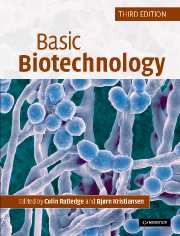Book contents
- Frontmatter
- Contents
- List of contributors
- Preface to the second edition
- Preface to the third edition
- Part I Fundamentals and principles
- Part II Practical applications
- Chapter 12 High-throughput screening and process optimisation
- Chapter 13 The business of biotechnology
- Chapter 14 Amino acids
- Chapter 15 Organic acids
- Chapter 16 Microbial polysaccharides and single cell oils
- Chapter 17 Environmental applications
- Chapter 18 Production of antibiotics by fermentation
- Chapter 19 Strategies of cultivation
- Chapter 20 Enzyme biotechnology
- Chapter 21 Recombinant proteins of high value
- Chapter 22 Insect and mammalian cell culture
- Chapter 23 Plant cell biotechnology
- Chapter 24 Biotransformations
- Chapter 25 Immunochemical applications
- Index
Chapter 22 - Insect and mammalian cell culture
Published online by Cambridge University Press: 05 June 2012
- Frontmatter
- Contents
- List of contributors
- Preface to the second edition
- Preface to the third edition
- Part I Fundamentals and principles
- Part II Practical applications
- Chapter 12 High-throughput screening and process optimisation
- Chapter 13 The business of biotechnology
- Chapter 14 Amino acids
- Chapter 15 Organic acids
- Chapter 16 Microbial polysaccharides and single cell oils
- Chapter 17 Environmental applications
- Chapter 18 Production of antibiotics by fermentation
- Chapter 19 Strategies of cultivation
- Chapter 20 Enzyme biotechnology
- Chapter 21 Recombinant proteins of high value
- Chapter 22 Insect and mammalian cell culture
- Chapter 23 Plant cell biotechnology
- Chapter 24 Biotransformations
- Chapter 25 Immunochemical applications
- Index
Summary
Introduction
Bacteria and yeasts have been the organisms of choice for the industrial production of heterologous recombinant proteins for many years. The ability to cultivate bacterial strains to high cell density at large scale has become an increasingly important technique throughout the field of biotechnology, from basic research programmes (structural or kinetic studies) to large-scale pharmaceutical production processes. Escherichia coli remains one of the most attractive organisms for the production of recombinant proteins (see Chapters 4, 5, and 21 for examples) where no complex post-translational modifications (e.g. glycosylation or disulphide bond formation) are required for biological activity and because its genetics and physiology are well understood. However, there are important drawbacks associated with the use of prokaryotic organisms. The low percentage of GC nucleotides in their genomes, when compared to mammalian genes, and the existence of rare codons that often result in low expression levels or inactive truncated forms and, in many cases, proteins are expressed as insoluble inclusion bodies in the bacterial periplasmic space. Bacteria are also incapable of carrying out any post-translational modifications, which strongly influences protein stability, folding, solubility and, hence, its biological activity. Yeasts (e.g. Saccaromyces cerevisiae or Pichia pastoris), though, can perform some post-translational modifications similar to those of the more complex eukaryotic cells (see Chapter 5). However N-glycosylation of mammalian proteins in yeast seems to be very inefficient. Additionally, both bacteria and yeast cells are surrounded by a mechanically strong cell wall that may hinder recovery of any non-secreted proteins.
- Type
- Chapter
- Information
- Basic Biotechnology , pp. 523 - 548Publisher: Cambridge University PressPrint publication year: 2006



